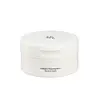What's inside
What's inside
 Key Ingredients
Key Ingredients

 Benefits
Benefits

 Concerns
Concerns

 Ingredients Side-by-side
Ingredients Side-by-side

Cetyl Ethylhexanoate
EmollientIsopropyl Myristate
EmollientPEG-20 Glyceryl Triisostearate
EmollientSynthetic Wax
AbrasivePEG-10 Isostearate
Emulsifying1,2-Hexanediol
Skin ConditioningMorus Nigra Fruit Extract
Skin ConditioningGlycyrrhiza Glabra Root Extract
BleachingPanthenol
Skin ConditioningSoluble Collagen
HumectantCeramide NP
Skin ConditioningSodium Hyaluronate
HumectantHydroxypropyltrimonium Hyaluronate
Sodium Acetylated Hyaluronate
HumectantHydrolyzed Hyaluronic Acid
HumectantHyaluronic Acid
HumectantSodium Hyaluronate Crosspolymer
HumectantHydrolyzed Sodium Hyaluronate
Skin ConditioningPotassium Hyaluronate
Skin ConditioningGlycerin
HumectantButylene Glycol
HumectantEthylhexylglycerin
Skin ConditioningWater
Skin ConditioningCetyl Ethylhexanoate, Isopropyl Myristate, PEG-20 Glyceryl Triisostearate, Synthetic Wax, PEG-10 Isostearate, 1,2-Hexanediol, Morus Nigra Fruit Extract, Glycyrrhiza Glabra Root Extract, Panthenol, Soluble Collagen, Ceramide NP, Sodium Hyaluronate, Hydroxypropyltrimonium Hyaluronate, Sodium Acetylated Hyaluronate, Hydrolyzed Hyaluronic Acid, Hyaluronic Acid, Sodium Hyaluronate Crosspolymer, Hydrolyzed Sodium Hyaluronate, Potassium Hyaluronate, Glycerin, Butylene Glycol, Ethylhexylglycerin, Water
Cetyl Ethylhexanoate
EmollientCaprylic/Capric Triglyceride
MaskingPEG-20 Glyceryl Triisostearate
EmollientSynthetic Wax
AbrasivePEG-10 Isostearate
EmulsifyingLactobacillus/Soybean Ferment Extract
Skin ConditioningHippophae Rhamnoides Oil
EmollientOryza Sativa Bran Oil
EmollientOryza Sativa Seed Water
AntimicrobialAvena Sativa Meal Extract
SoothingCoix Lacryma-Jobi Ma-Yuen Seed Extract
Skin ConditioningOryza Sativa Extract
AbsorbentWater
Skin ConditioningSorbitan Sesquioleate
EmulsifyingGlycerin
HumectantPropanediol
SolventButylene Glycol
Humectant1,2-Hexanediol
Skin ConditioningCaprylyl Glycol
EmollientEthylhexylglycerin
Skin ConditioningCetyl Ethylhexanoate, Caprylic/Capric Triglyceride, PEG-20 Glyceryl Triisostearate, Synthetic Wax, PEG-10 Isostearate, Lactobacillus/Soybean Ferment Extract, Hippophae Rhamnoides Oil, Oryza Sativa Bran Oil, Oryza Sativa Seed Water, Avena Sativa Meal Extract, Coix Lacryma-Jobi Ma-Yuen Seed Extract, Oryza Sativa Extract, Water, Sorbitan Sesquioleate, Glycerin, Propanediol, Butylene Glycol, 1,2-Hexanediol, Caprylyl Glycol, Ethylhexylglycerin
 Reviews
Reviews

Ingredients Explained
These ingredients are found in both products.
Ingredients higher up in an ingredient list are typically present in a larger amount.
1,2-Hexanediol is a synthetic liquid and another multi-functional powerhouse.
It is a:
- Humectant, drawing moisture into the skin
- Emollient, helping to soften skin
- Solvent, dispersing and stabilizing formulas
- Preservative booster, enhancing the antimicrobial activity of other preservatives
Butylene Glycol (or BG) is used within cosmetic products for a few different reasons:
Overall, Butylene Glycol is a safe and well-rounded ingredient that works well with other ingredients.
Though this ingredient works well with most skin types, some people with sensitive skin may experience a reaction such as allergic rashes, closed comedones, or itchiness.
Learn more about Butylene GlycolCetyl Ethylhexanoate is an emollient ester. It comes from cetearyl alcohol and 2-ethylhexanoic acid.
Cetyl Ethylhexanoate is an emollient that adds a velvety feel to skin without being greasy or oily. Emollients help trap moisture into your skin, keeping your skin soft and hydrated.
Ethylhexylglycerin (we can't pronounce this either) is commonly used as a preservative and skin softener. It is derived from glyceryl.
You might see Ethylhexylglycerin often paired with other preservatives such as phenoxyethanol. Ethylhexylglycerin has been found to increase the effectiveness of these other preservatives.
Glycerin is already naturally found in your skin. It helps moisturize and protect your skin.
A study from 2016 found glycerin to be more effective as a humectant than AHAs and hyaluronic acid.
As a humectant, it helps the skin stay hydrated by pulling moisture to your skin. The low molecular weight of glycerin allows it to pull moisture into the deeper layers of your skin.
Hydrated skin improves your skin barrier; Your skin barrier helps protect against irritants and bacteria.
Glycerin has also been found to have antimicrobial and antiviral properties. Due to these properties, glycerin is often used in wound and burn treatments.
In cosmetics, glycerin is usually derived from plants such as soybean or palm. However, it can also be sourced from animals, such as tallow or animal fat.
This ingredient is organic, colorless, odorless, and non-toxic.
Glycerin is the name for this ingredient in American English. British English uses Glycerol/Glycerine.
Learn more about GlycerinPEG-10 Isostearate isn't fungal acne safe.
Peg-20 Glyceryl Triisostearate comes from Isostearic Acid and glycerin.
It is an emollient, emulsifier, and gentle cleanser. As an emollient, it helps trap moisture to keep skin soft and hydrated. Emulsifiers help prevent ingredients from separating.
This ingredient is common in oil-based products. This is because it helps oil-ingredients be easily washed away without leaving a residue.
Peg-20 Glyceryl Triisostearate may not be fungal-acne safe.
Learn more about PEG-20 Glyceryl TriisostearateSynthetic Wax is created from fossil fuels such as natural gas. It is used to enhance texture, adjust pH, and as an occlusive.
It may also be used as an abrasive ingredient to exfoliate the skin.
Synthetic Wax may not be fungal acne safe.
Learn more about Synthetic WaxWater. It's the most common cosmetic ingredient of all. You'll usually see it at the top of ingredient lists, meaning that it makes up the largest part of the product.
So why is it so popular? Water most often acts as a solvent - this means that it helps dissolve other ingredients into the formulation.
You'll also recognize water as that liquid we all need to stay alive. If you see this, drink a glass of water. Stay hydrated!
Learn more about Water